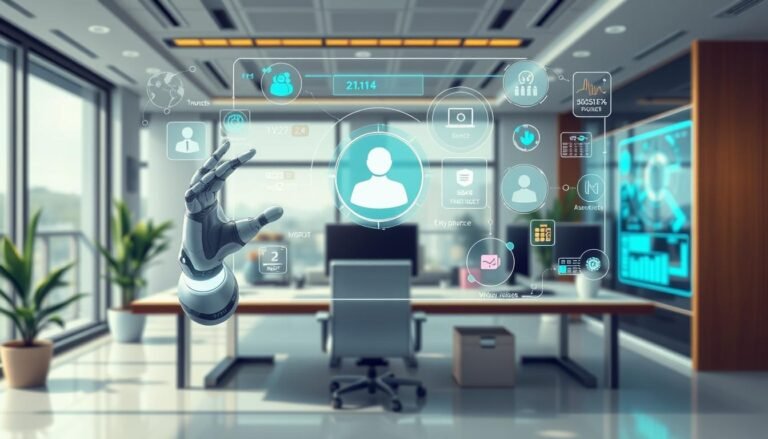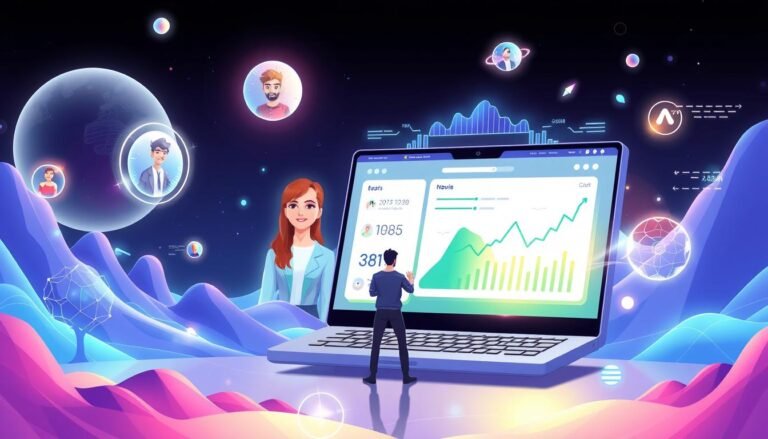AI and Big Data: A Powerful Combination for Market Insights
Do you wonder how businesses really understand what we want and need? The key is a mix of AI and Big Data. This combo lets companies make smart choices, staying ahead in today’s busy markets.
AI and Big Data Analytics are changing how businesses see the market. Big data means lots of complex information that companies use to find valuable insights. AI makes it possible for computers to think like humans. This tech enables cool things like recognizing speech and images.
How do AI and Big Data team up to give better market insights? How can businesses use predictive analytics to find nuggets of gold in huge piles of data? Today, let’s dive into how AI and Big Data are changing the game for businesses.
Key Takeaways:
- AI and Big Data Analytics revolutionize market insights by allowing businesses to extract valuable information and insights from massive and complex datasets.
- Big data refers to the vast amount of data that businesses analyze to make data-driven decisions and increase efficiency and revenue.
- AI enables computers to simulate human intelligence and perform tasks like speech and image recognition.
- The convergence of AI and Big Data enhances predictive analytics and enables businesses to extract actionable insights from their data.
- The future of AI and Big Data holds great promise, with continuous advancements and growth expected in market insights.
What is Big Data?
Big data refers to large, complex, and fast-moving datasets. They need advanced tools and methods to understand. Artificial Intelligence (AI) and Machine Learning (ML) now help businesses use big data. They can get important insights, make smart decisions, and do better in many ways.
Now, in the age of AI and ML, big data is like fuel for making choices. By looking at lots of data, companies see patterns and connections. This helps them make decisions based on solid facts. It also helps them compete better in their industry.
Using AI and ML together means powerful analyses of big data. AI’s learning ability finds new insights that earlier tools might have missed. This mix helps businesses learn a lot about what customers want, trends in the market, and more.
“Big data is not about the data itself, but rather the valuable insights and actionable information that it can reveal.”
Driving Business Insights through Big Data and AI
Big data and AI together offer insights that help businesses improve. They influence many important areas. For example:
- Customer Insights: By looking at large amounts of customer data, companies can know more about their clients. This helps them make marketing better, choose what products to sell, and improve how customers feel about their brand.
- Operational Efficiency: These technologies can also help a company run smoother by finding and fixing problems before they happen. They can help businesses make quick decisions based on real-time data. This can cut costs and make things work better.
- Risk Management: Using AI to watch over data can spot issues, like fraud or security risks. This early warning system can save a company from big problems.
- Market Trends and Insights: By examining lots of data, companies can see what’s coming in their market. It helps them be ready and smart in dealing with changes and competition.
The Role of Machine Learning in Big Data Analytics
Machine Learning is key in understanding big data. It speeds up finding important insights from large, complex data. It helps businesses do things like:
- Identify Patterns: ML can find patterns and links in huge amounts of data. This is very helpful for making good decisions and getting better results.
- Predict Outcomes: By looking at past data, ML can say what might happen in the future. It can predict things like customer behavior or market trends.
- Optimize Processes: ML can also make how a company works better. It finds waste, automates tasks, and suggests ways to improve based on data.
AI and big data are changing how many industries work. Companies that use these technologies well can make smart choices, innovate, and succeed in a world that’s driven by data.
What is AI?
AI, or Artificial Intelligence, means making computers think like humans. It includes things like knowing what we say, recognizing images, driving cars on their own, and using big data to help us understand things better. These are part of AI and its subfields, such as machine learning and natural language processing.
Machine learning teaches computers to do things without being told by people. It’s really important in AI. It has changed a lot of fields, like health care, finance, and online shopping.
Another key part is deep learning. It helps computers see complex patterns in lots of data. This is why we’re getting better at recognizing images and understanding speech.
The role of AI in various domains:
- Natural Language Processing (NLP): This lets computers understand and use human languages. Think of chatting with a robot or getting online translations.
- Cognitive Computing: Cognitive computing tries to mimic how our brains work. It uses machine learning and other ways to help computers think, reason, and learn.
“AI is changing everything. From self-driving cars to suggesting your next favorite song, it’s making big changes in our lives and jobs.”
- Speech recognition
- Image recognition
- Autonomous driving
In simple terms, AI helps computers act like us, improving many fields. With its subfields, it’s leading us to a new tech-driven future.
| Subfields of AI | Main Applications |
|---|---|
| Machine Learning | Healthcare, Finance, E-commerce |
| Deep Learning | Image Recognition, Speech Recognition |
| Natural Language Processing | Virtual Assistants, Language Translation |
Relationship Between AI and Big Data
AI and big data work together to offer deep analysis and useful insights. AI mimics how humans think and learns better with lots of data. Big data analysis, on the other hand, uses AI to improve understanding and find secrets in large data sets.
Together, AI and big data help companies use their data well and become more data-focused. They can predict future trends with the help of AI and analyze data more efficiently. This way, businesses gain a competitive advantage and understand their customers better.
A key strength of AI is its ability to handle huge and fast data. When combined with big data analysis, businesses can make smart moves for growth and staying ahead. They get a crucial set of tools for spotting market trends and making their operations better.
“The merging of AI and big data is changing how companies interpret and use their data. This combo lets businesses see the market clearer, make better decisions, and succeed more.”
Benefits of the Relationship Between AI and Big Data
AI and big data working together offers several plusses for companies:
- Enhanced analytics capabilities through predictive analytics and augmented analytics
- Improved decision-making processes based on accurate and timely insights
- Deeper knowledge of consumer preferences and market shifts
- Cutting costs and working more efficiently
- Making more money and beating competitors with smart, data-backed strategies
Illustrative Example:
Imagine a top e-commerce company applying AI to its customer data. This includes what customers buy and how they browse. With big data, AI finds patterns and predicts what they might buy next. Then, the company can suggest products that customers are likely to want. This smart use of AI and big data gives the company an edge in the market. It makes customers happier and brings in more sales.
AI in Big Data Analytics
Artificial Intelligence (AI) is key in the big data analytics process. It boosts data, pattern, decision, action, and risk management. AI speeds up data preparation, finds human errors, and helps in exploring data.
AI is vital for machine learning. It lets computers learn from data, not just what they’re told. AI analyzes big data to find patterns and insights. This helps companies make data-informed choices and improve how they work.
AI assists in managing data. It automates tasks like cleaning and blending data. By watching users, AI suggests data sources. It also points out possible data connections and trends.
AI is great at managing patterns. It looks at old data to find trends and connections. It spots things we might have missed. This can help companies see new trends or what customers like.
In making decisions, AI is very helpful. It uses data to suggest choices based on past behavior. Companies can then make better decisions that help them grow. This supports choosing how to move forward.
Transforming Business with Machine Learning
“Machine learning lets companies understand big data by seeing patterns, predicting future trends, and making tasks easier. AI helps companies get ahead in the data-rich world we live in.”
AI can help with action management by doing tasks automatically. This includes making reports or sending alerts. It makes operations smoother, reduces mistakes, and uses resources better.
AI also aids in goal management. It helps companies meet their goals by studying past data. AI shows what factors are key to success. This lets businesses tweak their plans for better results.
In risk management, AI is invaluable. It looks at lots of data to find potential issues. This could be security problems or fraud. AI alerts teams to these issues, helping them act fast to stay safe.
AI’s role in big data analytics is changing how businesses use information. AI helps get deeper insights from data, improve decision making, and innovate. By using AI for data work, businesses can truly embrace big data and be more competitive.
Synergy in Technology Innovation
The blend of Big Data and AI unlocks new potential in research and tech. Big Data relies on AI‘s methods to sift through big datasets. On the flip side, AI needs Big Data to make better decisions. This partnership boosts progress, allowing businesses to smartly use complex data.
“The merger of Big Data with AI is changing how we do research and innovate. Together, these two can turn huge datasets and smart algorithms into progress.”
– John Smith, Chief Data Scientist at InnovateTech
Work in Big Data and AI has brought many tech breakthroughs. By using analytics and AI, companies can understand large, varied data. This understanding powers new tech and helps companies be more innovative, improve operations, and stand out from the competition.
Innovation through Big Data and AI
Mixing Big Data with AI changes the way decisions are made. By looking at huge amounts of data, companies can find clear actions to take. AI helps find patterns and relationships, so the decisions are better and based on evidence.
This duo also helps create advanced solutions for real problems. By putting AI on big data, companies are making smart things like self-driving cars. These innovations don’t just make life better but also help the economy and society move forward.
Empowering Decision Making
Big data and AI make decisions smarter by giving companies powerful insights. They can look closely at market trends and customer habits. This deep understanding leads to spot-on predictions, safer moves, and solid strategies for growth.
Using AI and big data, companies can see market changes coming and grab new chances. With smarter analytics, they become market leaders, thanks to the insights AI and big data provide.
The Future of Research and Innovation
The mix of Big Data and AI will keep driving research and innovation. As tech and data grow, new doors for exploring and solving emerge. This mix offers great chances for making strides in healthcare, finance, and the environment.
By leading in Big Data and AI, companies can stay ahead, drive innovation, and shape their sectors. This tech duo offers big chances to create a smarter, more united world.
| Benefits of Synergy in Technology Innovation |
|---|
| 1. Enhanced decision-making capabilities |
| 2. Accelerated technological advancements |
| 3. Deeper insights and understanding of complex data |
| 4. Improved accuracy in forecasting and risk assessments |
| 5. Increased competitive advantage |
The Benefits of Big Data
Big data is key in market research for several reasons. It lets researchers collect and study a lot of info. This gives a better look at what consumers do and like.
Big data also offers real-time details in market research. Businesses can analyze current data fast. They then get the latest info on market shifts and what people want. This helps make quick decisions and changes.
“Big data not only improves the accuracy of market research but also provides a larger and more diverse dataset.”
Market research gets much better with big data’s help. It pulls from a wide set of data, making insights more accurate and broad. New methods, like machine learning, allow for deeper data dives.
Real-time Insights and Agile Decision-making
Getting updates in real time is a big plus for market research with big data. It lets businesses see and adapt to changes happening now. This flexibility leads to better-targeted outreach and products.
Enhanced Accuracy and Deeper Insights
Big data offers a lot more info for market studies. This means research is more precise and thorough. By looking at huge amounts of data, businesses can spot subtle trends and understand what consumers want.
The image above shows how big data uncovers market trends and preferences. It lets businesses react to new trends quickly.
- Big data enables businesses to gather and analyze large amounts of data.
- Real-time insights allow for agile decision-making.
- Big data improves the accuracy of market research.
- Advanced analytical techniques like machine learning provide deeper insights into consumer behavior and preferences.
Overall, big data is a game-changer for market research. It helps businesses make smarter decisions and keep up with what’s new.
The Power of Predictive Analytics
Predictive analytics is a key part of big data. It helps organizations guess what consumers will like and how successful marketing will be. It looks at lots of data to find patterns and trends. This lets businesses make smart choices and beat their rivals.
Taking on heaps of data, predictive analytics gives insights on consumer behavior. It learns from the past to guess on the future. This data helps brands make better strategies. They make products and offer services people really want.
This tool also helps brands guess how well their ads will do. By looking at consumer info and old ad results, they can see what works. This helps them tweak their plans to get more bang for their buck.
For example, think of a shop. They can figure out which ads are best for pulling in new customers. With insights into what folks like, ads can speak directly to the right people. More of the right ads mean more folks buying.
Predictive analytics does more than pick out trends. It helps brands run smoother, use their stuff better, and make people happier. With its help, companies can plan their stock, guess what folks want, and work their supply chains better. All this leads to saving money and happier customers.
“Predictive analytics lets brands figure out what customers want, guess future trends, and run better ads, keeping ahead of the competition.”
The world of big data and analytics is growing fast. As companies gather and study more data, they will get better at predicting what’s next. This means smarter moves for those who use big data and predictive analytics. They’ll have an edge in today’s fierce, data-driven market.
Key Benefits of Predictive Analytics:
- Accurate forecasting of consumer behavior and preferences.
- Optimization of marketing campaigns for maximum ROI.
- Improved resource allocation and operational efficiency.
- Enhanced customer satisfaction through personalized experiences.
- Strategic decision-making based on data-driven insights.
Predictive analytics helps organizations know customers and guess market trends. This mix of big data and predictive analytics gives businesses a leg up in today’s ever-changing market.
| Predictive Analytics | Big Data | Forecasting | Consumer Behavior | Marketing Campaigns |
|---|---|---|---|---|
| Utilizes advanced analytics techniques to make predictions and forecasts based on historical and real-time data. | Provides the vast amount of data required for accurate predictions and insights. | Enables businesses to forecast market trends and make proactive decisions. | Empowers organizations to understand consumer preferences, behaviors, and trends. | Optimizes marketing campaigns for maximum effectiveness and ROI. |
The Challenges of Big Data
Big data brings benefits but also several hurdles to clear. To manage its massive size and speed, organizations need advanced data management systems. These systems are crucial for the storage, organization, and quick retrieval of data.
Accuracy in analyzing big data poses a significant hurdle. The amount of data can lead to wrong insights or misread facts. To avoid this, companies must set up checks to ensure their data is accurate and reliable.
Getting real-time insights from big data is vital for quick market responses. But, analyzing huge data sets instantly is challenging. Technologies like in-memory computing and stream processing aid in gaining real-time insights for fast decision-making.
“The analysis of massive datasets in real-time can be demanding, requiring efficient processing and storage solutions.”
Here’s a table to offer a clearer view on the challenges of big data and their solutions:
| Challenges | Solutions |
|---|---|
| Volume and Velocity | Implement advanced data management systems to handle the scale and speed of big data. |
| Accuracy | Establish robust quality checks and data validation processes to ensure accurate analysis. |
| Real-Time Insights | Utilize technologies like in-memory computing and stream processing for efficient real-time analysis. |
By meeting these challenges head-on, organizations can fully use big data. This allows them to make informed decisions and stay ahead in the market.
Emerging Trends and Future of Big Data
The future is bright for big data. Its growth will keep speeding up. Cloud computing has changed how companies handle huge amounts of data. This change makes managing and analyzing data much easier.
The more data there is, the more important data privacy becomes. People want more say in how their personal data is used. As a result, rules about data privacy are becoming stricter. Companies that protect data well earn trust from customers.
New AI and machine learning technologies are making waves in big data analysis. AI can now spot patterns in vast amounts of data. This helps companies make smarter, faster decisions.
Big data’s influence isn’t just in tech anymore. Health, finance, and manufacturing are also catching on. They see the value in using big data to spark new ideas and work more efficiently.
In short, big data is on the upward path. Thanks to cloud computing, a focus on privacy, and AI, companies can do more with data. This will help them stay ahead in their fields.
Conclusion
AI and Big Data have changed how businesses understand customers. They use Big Data’s analysis and AI’s learning to make smart choices. This helps them keep up with their rivals.
The future for AI and Big Data looks bright. They will grow and become more advanced. As more data appears, AI will help process it faster. Cloud computing will be vital for handling all this information.
Businesses must focus on keeping data safe as people care more about their privacy. AI and machine learning will make Big Data even more useful. They will find hidden insights, letting companies improve their strategies and performance.
The journey ahead is exciting for AI and Big Data. They will help businesses see what’s happening in the market and guess what customers will want. Those using these tools well will do great in the data-centric, tough market.







